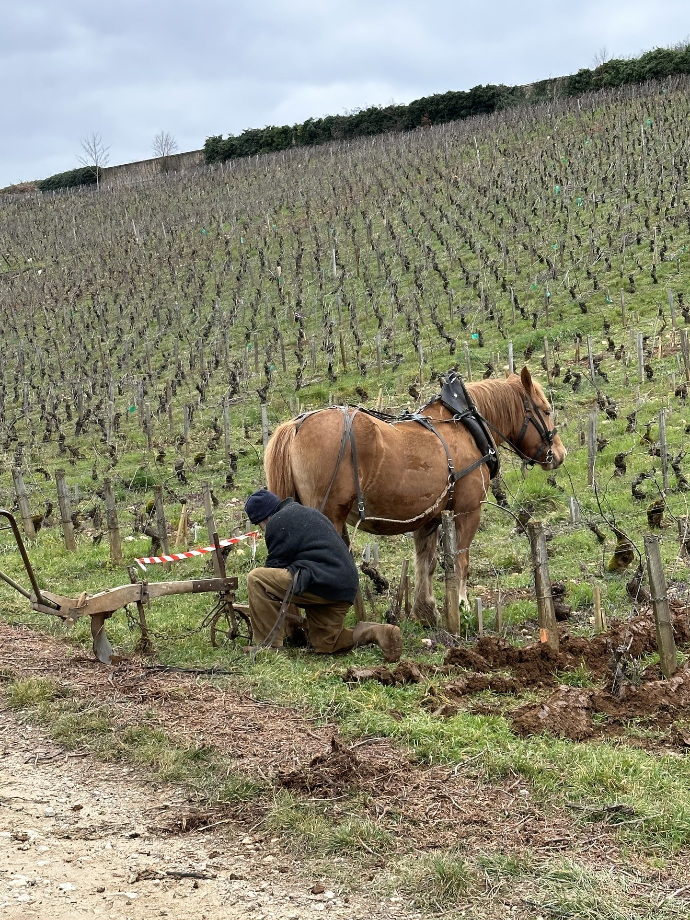Tome #4 - Une étude en Contraste
19 Mars 2025 | Alexander Mackh, Cofondateur d'Amelie
La Bourgogne est une région où chaque détail compte. Le sol, l'exposition de la vigne, le climat — chaque élément contribue à façonner le caractère de ses vins. Au cœur de cette complexité se trouve le Pinot Noir, un cépage qui exige précision et transparence. Nulle part cela n’est plus évident qu’en Côte de Nuits, où le Pinot Noir atteint son expression la plus pure. Sur ce petit aire géographique privilégié, deux villages se distinguent : Nuits-Saint-Georges et Chambolle-Musigny. Bien qu’ils partagent le même cépage, ces deux appellations village ne pourraient produire des vins plus contrastés.

La différence entre ces deux appellations emblématiques commencent sous la surface. Chambolle-Musigny repose sur un sol léger, calcaire et crayeux, qui draine parfaitement et force les vignes à se nourrir dans la terre. C’est ce qui confère aux vins cette finesse incomparable et cette pureté aromatique qui leur est propre. À l’inverse, Nuits-Saint-Georges se distingue par son sol plus complexe, un mélange de calcaire, d’argile et de marne. L’argile, plus présente, retient l’eau, permettant ainsi aux vins de gagner en structure, en profondeur et en puissance. Ces variations de terroir façonnent non seulement la manière dont la vigne s’épanouit, mais également la manière dont les vins expriment leur caractère unique.
Le climat, lui aussi, joue un rôle essentiel. Chambolle-Musigny bénéficie d’un léger avantage, avec une pente douce qui garantit une exposition régulière au soleil et des températures modérées. Cela permet aux raisins de mûrir de manière constante, offrant un équilibre naturel aux vins. Nuits-Saint-Georges, en revanche, présente une plus grande variabilité. Certains vignobles se trouvent à des altitudes plus élevées, où les températures plus fraîches ralentissent la maturation et accentuent la trame acide des vins. D’autres, influencés par des vallées sèches ou des combes, accueillent de l’air plus froid, ce qui génère des variations de températures plus marquées. Ces différences donnent naissance à une palette de styles plus large au sein du village, allant de vins fermes et structurés à des expressions plus souples et concentrés.
Avec la viticulture, c’est la nature qui fournit la base, mais ce sont les choix du vigneron qui façonnent l’expression finale. Certains producteurs privilégient la fermentation en grappes entières, tandis que d'autres préfèrent un éraflage complet. Certains optent pour un élevage en fûts neufs, d'autres choisissent des contenants neutres. La durée de la macération, le type de cuve de fermentation, et l'approche de l'extraction influencent tous le vin final. Si nombre de vignerons affirment laisser simplement parler le terroir, en réalité, leurs choix marquent une empreinte indélébile sur le vin.
La Bourgogne est souvent comprise a travers son hiérarchie de classification, divisant les vignobles en appellation village, Premier Cru et Grand Cru. Chambolle abrite le Grand Cru Musigny, tandis que Nuits-Saint-Georges ne possède pas de grands crus, bien que certains estiment que des sites comme Les Saint-Georges méritent ce statut. Au-delà de ces étiquettes, ce qui compte véritablement, c’est l’identité propre de chaque vin et ce qui est certain est que ces deux villages produisent des vins probants et singuliers.
Malgré leurs différences, Nuits-Saint-Georges et Chambolle-Musigny partagent une finalité commune : laisser le Pinot Noir s'épanouir sous tous ses avatars. Les vins de Chambolle sont façonnés par le calcaire, des températures modérées et un travail précis des vignes. Ceux de Nuits, avec leurs sols variés et leurs climats changeants, révèlent souvent plus de structure et de puissance. Mais peu importe d'où vient le vin, chaque bouteille raconte l’histoire d’un lieu, d’un millésime et des hommes et femmes qui lui donnent vie.